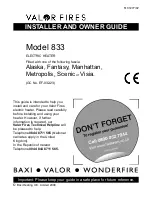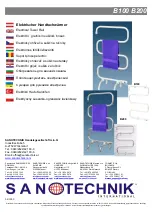
40
Installation Manual
40
Installation
1. Installing the water heater
• Put the water heater where it is protected from frost (4 to 5° C minimum).
• Position it as close as possible to the most frequently used taps.
• If it is installed in an uninhabited room (store-room, cellar, garage) the pipes and
safety devices should be insulated.
• The continuous ambient temperature around the water heater must not exceed
40°C, so provide ventilation if necessary.
• Make sure that the wall-bracket is strong enough to carry the weight of the water
heater when full of water.
• Allow 550 mm in front of each electrical element for periodic maintenance of the
heating element.
•
A drip tray must be installed under the water heater if it is positioned in a false
ceiling, an attic or above living areas. An outlet connected to a drainpipe is neces-
sary.
• Ventilation must be provided in damp locations.
1.1 Installing a vertical wall-mounted water heater (VM)
The heater is easily moved by lifting handles built into the ends. There are several
ways of fixing it, depending on the nature of the walls.
Thin walls (plasterboard partitions):
Ø 10 mm threaded rods traversing the wall, connected by profiles or backplates.
Hard, thick walls (concrete, stone or brick):
Grout in Ø 10 mm bolts, or drill to take Ø 10 mm plugs.
For both types of walls, use the drilling template printed on the carton and check the
measurements before drilling.
Walls not able to bear significant weight
The vertical wall-mounted water heaters can be placed on a pedestal if the wall
cannot support the weight of the appliance. The top bracket must however be fixed.
Use the pedestal recommended by the manufacturer.
1.2 Installing a vertical water heater on a pedestal (VS)
The heater is placed on the ground with shoes fixed under its base. No wall attach-
ment is needed.
A heightening frame may be fixed under the heater to leave space for the pipes (H :
220 mm – optional accessory).
1.3 Installing a horizontal wall-mounted water heater (HM)
Once the water heater is installed, the hydraulic connections and the cover must
always be vertical and below the appliance.
5
Manuel d’utilisation
FR
3. La commande nomade
3.1 Vérifications préalables
Charge de l’accumulateur
Le chauffe-eau doit être mis sous tension pendant au moins seize heures
en continu pour pouvoir recharger l'accumulateur assurant la transmis-
sion vers la commande nomade.
Dans le cas d'une double tarification (heures creuses / heures pleines),
utiliser le contacteur du chauffe-eau pour le mettre en marche forcée.
Si l'accumulateur n'est pas suffisamment chargé, la communication radio
peut connaître des coupures
Installation des piles sur la commande nomade
S'assurer que les piles sont bien installées dans la commande nomade.
Voir le paragraphe Mise en place des piles, page 40.
Réglage date et heure
Vérifier le réglage du jour et de l'heure en appuyant sur la touche
Voir le paragraphe Réglage du jour et de l’heure, page 42.
Un mauvais réglage du jour et de l'heure peut engendrer un
dysfonctionnement du chauffe-eau.
Une fois ces vérifications réalisées, vous pouvez procéder à la mise en
place de la commande nomade.
Manuel utilisation FR.book Page 5 Mercredi, 23. décembre 2009 11:32 11
















































